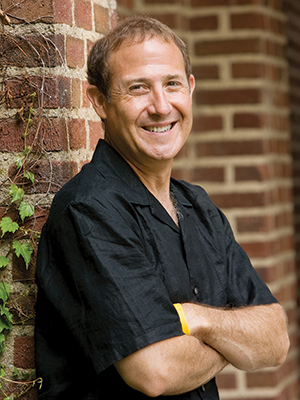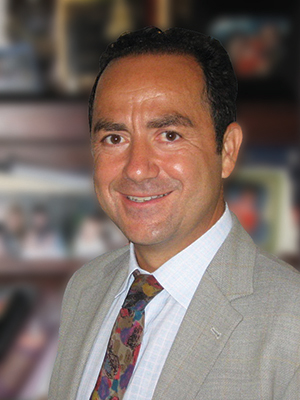Our daughter, 15, was just diagnosed with leukemia. She feels alone and confused. How can we help?

Bradley Zebrack, Associate Professor at the University of Michigan School of Social Work in Ann Arbor Photo by Jerome Rork
The first thing to remember is that you are her emotional and social support. Second, find opportunities for your daughter to meet other teens and young adults who have had cancer, which will help her to feel less alone. Seeing other young people who have survived can instill in her mind a picture of hope and a possible vision for her future. She also may be interested in programs for teens and young adults with cancer, like Camp Mak-A-Dream’s Teen Camp or Young Adult Conference.
It’s important to remember that your daughter is at an age where she needs to make some important decisions on her own. This would be true even if she didn’t have cancer. So turn her on to these resources and then leave her be. She needs to take ownership of her battle with cancer and feel like she’s fighting it for herself, and not for you. Be there to love her, hold her and squeeze her, feed her and bathe her, when she needs it, but give her space to cope with this challenge. Be her parent and be her partner. Research indicates that involving the child in treatment decisions is important for healthy growth and development, and for positive coping and adjustment with cancer. Involving a child in treatment decisions can also promote adherence to therapy.
Although 15-year-olds are not mature enough to always make rational and reasonable decisions, they are at a time in life where they are capable of learning how to do that, which often includes trial and error. It’s hard for parents to let their kids fall, but we can support them best by being there for them when they do. An oncology social worker can help you as a parent communicate with your daughter, and also assist [your daughter] with decision making.
The best way to assess whether or not your daughter should be referred to therapy is to have a health care professional do a formal assessment. This could be a social worker or nurse at the site where she is receiving treatment. I also would encourage you and your partner to seek support for yourselves.
SUPPORT FOR TEENS WITH CANCER // Cancer Really Sucks provides a website where teens and their friends and siblings can give and get support. // Group Loop allows teens to instant message, participate in live discussion groups and create blogs. // Look Good Feel Better’s 2bMe website provides information for teens about the social side effects of cancer.
I often hear about things that may increase my risk of getting cancer, but what can I do to reduce my risk?

Ernest Hawk, Vice President and Division Head of the Division of Cancer Prevention and Population Sciences at the University of Texas M. D. Anderson Cancer Center in Houston Photo courtesy of Ernest Hawk
Smoking is still the most important modifiable risk factor for cancer. It raises a person’s risk for more than 10 types of cancer as well as other serious life-threatening conditions. There are a variety of things available to help [a person quit], and the benefits of cessation are almost immediate.
Although we don’t yet understand all of the mechanisms involved, being overweight or obese significantly increases risks for at least eight types of cancer. Obesity now ranks as the second leading modifiable cause of cancer. To reduce cancer risk and attain better health, you should eat more fruits and vegetables, eat less red and processed meat, and substitute whole grains for processed grains. It’s also important to exercise at least five days a week for at least 30 minutes a day at a moderate level of exertion.
There are effective vaccines or treatments that can reduce risk of some cancers. Globally, as much as 10 to 20 percent of cancer derives from chronic or persistent infections. Indeed, much of stomach, cervical and liver cancer is due to chronic infections—many of which can be prevented through vaccination or treated effectively. For example, the HPV vaccine can reduce cervical cancer risk by 75 percent or more.
Screening for cervical, colorectal and breast cancer is well established to reduce cancer mortality in the general or average risk population. [Cervical and colorectal cancer screening reduce cancer incidence; mammography allows for early detection, which can reduce mortality.] And we recently gained evidence that lung cancer screening may reduce cancer mortality rates by 20 percent among people who are at high risk due to prior or current smoking.
These simple things—stopping smoking, eating properly, getting proper levels of exercise, maintaining a healthy body weight, and undergoing recommended vaccination and screening—can cut cancer risk significantly, by as much as 40 to 60 percent when taken together.
Other risk factors include environmental, cancer-causing toxins. Things like asbestos, radiation and excess UV radiation from sunlight or tanning beds are well-established risks. Of course, there may be other environmental risk factors that we haven’t yet identified. But rather than focusing on the unknown, we should focus attention on what is known and actionable today.
In addition, certain people are born with a set of genes that can place them at very high risk of cancer. Fortunately, these syndromes are pretty rare, probably only accounting for 5 percent of all cancers. If you have a lot of cancer in your family, it occurs at early ages, you have more than one type of cancer or it occurs in both breasts, lungs, kidneys, testes or ovaries, it would be worth discussing genetic testing with your health care practitioner and a genetic counselor.
RISK REDUCTION INFORMATION // American Institute for Cancer Research lists ways to reduce your cancer risk. // Prevent Cancer Foundation provides materials in English and Spanish about ways to reduce cancer risk. // Smokefree.gov offers a step-by-step quit guide online and tools to help you quit.
I am in my 30s and will soon start chemo and radiation. I want to start a family after treatment. What are my options?

Kutluk Oktay, Director of the Division of Reproductive Medicine at New York Medical College in Valhalla and Founder and Director of the Institute for Fertility Preservation in Rye, N.Y. Photo courtesy of Kutluk Oktay
There will be numerous options based on the specifics of the patient. If the patient is female, the most established method requires ovarian stimulation and retrieval of eggs, which takes about two weeks. Nowadays we can do ovarian stimulation at any time, but the most ideal situation is to start with the initiation of the menstrual cycle. If she has a partner, embryo freezing is still more established than egg freezing. If she’s single, and she doesn’t have a desire to use donor sperm, then we would recommend egg freezing.
If the patient has cancer that’s sensitive to estrogen, particularly breast cancer, we would not want to use fertility drugs that increase estrogen levels. Instead, we would recommend using Femara (letrozole) [a breast cancer drug] for ovarian stimulation. Although the track record for this method is good, there still needs to be long-term follow-up (at least 10 years) from the studies that have been done to conclude with greater certainty that using Femara for ovarian stimulation is absolutely safe. We would also want to know if the patient carries a BRCA1 or BRCA2 mutation. Those who are BRCA1 carriers may produce fewer eggs in response to ovarian stimulation, which means they may require additional cycles to [get the desired number of eggs]. It’s important that these women are referred early in the process. The sooner they get to us, the more cycles of ovarian stimulation we can perform and, as a result, the more eggs we can freeze.
If there is little time, ovarian freezing may be an option. This involves removing the ovaries, freezing them in little pieces, and then, in the future, transplanting them back into the patient to restart ovarian function. Since I performed the first ovarian transplant in 1999, there have been around 20 claims of live births worldwide. This is considered an experimental procedure, so insurance companies may not cover it, but it is the only [fertility preservation] option for patients who have not gone through puberty. Another option for those with limited time is in vitro maturation. This experimental procedure, done at only a few fertility centers in the world, involves collecting eggs before they mature [in the ovary] and doing the maturation in a petri dish. However, these eggs usually are less likely to result in pregnancy.
If the patient is male, the easiest option is to freeze sperm. Only one collection is needed if it will be used for in vitro fertilization with intracytoplasmic sperm injection [injecting a single sperm inside the egg]. If the intent is to use intrauterine insemination, then as many vials as possible will need to be collected. If the patient is a young boy who has not reached puberty, then we can do testicular freezing. [Only a few centers perform this procedure.] This is even more experimental than ovarian freezing—there have been no practical reports of success. However, in a few decades, the technology may improve and better outcomes may be possible.
FERTILITY AFTER CANCER // Livestrong Fertility provides information and support to cancer patients and survivors. // Fertility Rescue, a program offered by the Sher Institutes for Reproductive Medicine, offers an egg freezing cycle at no cost to cancer patients. // Save My Fertility provides information to men with cancer.
Cancer Today magazine is free to cancer patients, survivors and caregivers who live in the U.S. Subscribe here to receive four issues per year.




